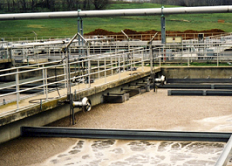 Discharging wastewater without going through any form of treatment, direct to the environment will cause heavy pollution which will be hard to clean up later. That is why we created an underground sewer system that flows to a treatment plant utilizing the best wastewater technologies that help to remove most of the pollutant before the water can be safely released into lakes or rivers. Generally a typical underground sewer system is designed to feed into a regional interceptor which is a complex underground network that runs through the city and combines together in a large chamber going to the treatment plant.
Discharging wastewater without going through any form of treatment, direct to the environment will cause heavy pollution which will be hard to clean up later. That is why we created an underground sewer system that flows to a treatment plant utilizing the best wastewater technologies that help to remove most of the pollutant before the water can be safely released into lakes or rivers. Generally a typical underground sewer system is designed to feed into a regional interceptor which is a complex underground network that runs through the city and combines together in a large chamber going to the treatment plant.Understanding wastewater treatment technologies is very important because as the country develops and more wastewater is generated we need to find a channel to properly treat it before discharge. Thus, as it requires a lot of resource to properly manage and handle the whole operation, it also teaches us the importance of prudent clean water management in our daily lives. Coming back to the subject of treatment setup usually the generation of water diverted from different sources are first collected in a huge underground well before it is channeled to the treatment plant. Here, it is full of dirt, rubbish, suspended solids, pollutants and it also contains high level of phosphorus which is a very hazardous element in the nitrogen cycle that can promote the growth of algae.
Wastewater technologies are pretty much straightforward as every step in the process plays a different role to reduce the amount of pollutant in the water. Let’s look at the whole process in details. For example, along the way traveling from the pumping station to the treatment building, the flowing water is being sprayed and mix with either aluminum sulfate (alum) or iron chloride, which are two chemicals used as a coagulant they gradually transforms phosphorus from liquid to solid so that it can be removed later on. Once the water reaches the treatment building it is diverted through a series of filter screens that function to removes any solid materials larger than a certain diameter size especially stones, papers and plastic in order to prevent accumulation of these materials that can jam up the whole system.
Filter presses will then be used to compact the rubbish collected and later squeezing out the excess water before disposal at landfill. The wastewater meanwhile flows into large compartments which we called grit chambers which function to further remove solid particles present in the water such as gravel and sands that gradually settle to the bottom. To get rid of phosphorus, which is a major element which we have discussed before that we need to reduce the level significantly; polymer must be added to facilitate its removal. When the wastewater left the pumping station, it was first spray with the coagulant in order to turn the phosphorus in the water into solid particles and now, the added polymer will bind all those particles forming what you call flocs, which is heavier than water and then sink to the bottom.
The wastewater can then be diverted to a clarifier which allows these large particles to settle down that usually takes about two hours and the sediment collected at the bottom is called sludge. In order to separate the sludge from the water, usually another type of polymer is added and then the wastewater is pumped through a filter press so that it can be easily squeezed out the water. Most of the sludge is then sent to giant incinerators to be burned off while the ashes will go into landfills. Dry sludge also sometimes undergoes further processing to be sold as organic fertilizers.
For further understanding on other related processes, I suggest you read up on these wastewater treatment articles as well.
» Sludge Dewatering
» Solid Bowl Centrifuge
» RBC Systems


